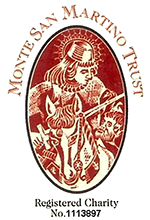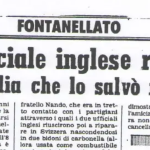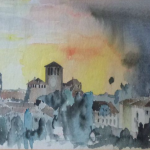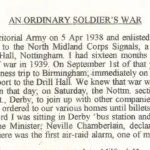Summary
In November 1943, after two months of trekking across the Appenines after their escape from Fontanellato PoW camp, Lt Frederick Lax of the Green Howards and three companions reached the village of Garulla in the Marche. Ten families agreed to look after them. The men stayed in Garulla until Spring 1944 before leaving and eventually reaching safety. After the war Frederick revisited Fontanellato and Montalbo, another of his PoW camps, but he was never able to return to Garulla.
During 2014-15, his son David and daughter Elizabeth gathered photos and papers he had left at his death into an illustrated document. David was determined to seek out the Guglielmi family in Garulla. With the assistance of MSMT trustees in the UK, and particularly of their colleagues Giuseppe Millozzi and Ian McCarthy in the Marche, they succeeded in tracking down the descendants of the Guglielmi family for a heart-warming reunion.
The full story follows, in two versions. The version in the first window below is the original scanned version of the story. In the second window below is the transcribed version in plain text.
[Digital page 1]
[Photograph with caption: Lieutenant Frederick Armah Lax 5th Green Howards 1942]
[Digital page 2]
Pilgrimage to Garulla in September 2015 – in the steps of Lieutenant Frederick Armah Lax – my Dad.
Over the past year my sister Elizabeth and I have been gathering together into an illustrated document the various photographs and handwritten papers our Dad, Frederick Lax, had left us after his death a few years ago. The texts consisted of a number of incomplete writings from the 1940s about his experiences as a Lieutenant in the Green Howards during World War 2, family photographs – some taken in Cyprus, North Africa and in particular in Italy – and a complete text entitled “My War” written by him in the late 1970s.
Among the photographs are several which we believe to have been taken in Garulla, Le Marche, of the families who sheltered Dad and three companion officers during the winter of 1943/1944, but regrettably without their names.
Dad had included in his writings details of the Guglielmi extended family who provided him sanctuary, but we never asked which of the photographs referred to which family members. We are to hear more of these photographs later in this story.
[Photograph – no caption: two young children]
[Photograph – no caption: seven adults and one child standing outside]
[Digital page 3]
The other three officers were Lieutenant Bill Ramshaw, Captain Bill Glover and Captain Sam Allcock, fellow prisoners of war held in Fontanellato.
Dad did revisit Montalbo and Fontanellato, two of the places where he was imprisoned, but never returned to Garulla. My wife Carole and I decided we needed to make that visit, with the hope that we might make contact with descendants of the Guglielmi family with a view to thanking them for what they had done for Dad and the others, and to understand better what risks the families there had taken.
We had heard of the Monte San Martino Trust from a Radio 4 documentary and decided to approach the Trust to enquire if anyone would be able in any way to assist us in our plans. The response from Letitia Blake was almost instant and beyond anything we could have hoped for. Our request for assistance was forwarded to Ian McCarthy and Giuseppe Millozzi and it transpires that the village of Garulla is only a few kilometres from Amandola, where Giuseppe lives and works, and not very many kilometres from Ian’s home, and Monte San Martino itself.
Within a couple of weeks of our approach to the Trust, Ian let us know that he had made contact with a granddaughter of one of the families who assisted my father, but told us no more, and we arranged to stay with Giuseppe in September 2015 to make our visits and hopefully meet the families in Garulla.
Giuseppe and Ian were to prove the most exceptional of hosts, guides and interpreters during our stay; the time they gave to ensure our visit was a memorable one was far in excess of anything we had expected or had any right to expect.
To understand why and how Dad found himself in Garulla in November 1943 we need to explain what happened to him and his companions after their escape/release from Fontanellato on the 9th of September 1943. He had been imprisoned in Italy since his capture in North Africa in 1942 – he was a Lieutenant in the 5th Battalion of the Green Howards. Some of his fellow officers decided to head north to Switzerland, but Dad wanted to go south with the intention of regaining Allied lines as soon as possible, so as to get back to the UK, and not have to be interned in Switzerland until the end of the war, whenever that would be. He and Bill Ramshaw were initially assisted in the vicinity of Fontanellato by “Minardi”, a farmer in Diolo and they attempted a rail journey south through Bologna, but a guide deserted them and they were nearly recaptured. A second journey south accompanied by Bill Ramshaw, now joined by Bill Glover and Sam Alcock, as well as another more reliable guide, was more successful, but trains were not running south of Rimini so the four escapees decided they would have to continue on foot. They decided to head for the Appenine [Apennine] mountains and follow remote trails, keeping clear of towns and villages, and seeking shelter whenever they could at remote farm houses.
Their long walk started at the beginning of November and they were to arrive in Garulla towards the end of that month.
The full story of these escapades and the long walk is told in Dad’s own words in “My War”, in which he describes in full all of his wartime service (unpublished family document).
[Digital page 4]
And so our own pilgrimage to Garulla began, with hopes of meeting people who remembered the POWs, of finding out who the people were in our photographs and, most important to be able to thank those who provided sanctuary at great risk to themselves. Dad had not been able to return, but we could belatedly tell the people we met how much the people of Garulla meant to him, and how much they had become part of our lives in the years from 1944 up to the present day.
[Photograph – no caption: landscape, presumed at Garulla]
[Photograph – no caption: man standing outside, mountains in background]
We did not know what to expect when Giuseppe and Ian took us both high into the mountains to Upper Garulla, which is a hamlet really, not linked to Amandola further down the valley by a surfaced road until about 1960. We climbed steadily and we began to realise that a remote village – without a surfaced road connection down into the valley was probably as good a place as any to spend the winter in what was in essence enemy territory.
[Photograph – no caption: Clara Guglielmi]
We drove through Garulla Inferiore and climbed further up into the hills to Garulla Superiore, along the narrow street between a small settlement of houses until we arrived at a modern house right at the west end of the village. We were greeted on the terrace of the home by a lady in her 80s – Clara Guglielmi – nee Sacchetti, who was a teenager in 1943, living in Lower Garulla. Her family was one of the 10 families who agreed to shelter my Dad and his companions.
[Digital page 5]
[Photograph – no caption: Paulo and Adriana Guglielmi]
We were also introduced to Paolo and Adriana Guglielmi, the latter being Clara’s daughter and granddaughter of Gervasio, one of the 3 brothers and 1 sister whose family details my father had recorded, and who had been at the forefront of providing shelter.
[Photograph with caption: The old gentleman on the right of this photograph is Adolpho Guglielmi, son of Gervasio and Maria Guglielmi, aged 94, Clara’s brother-in- law. He was in the army in the winter of 1943/1944, and his regiment was fighting on the side of the Allies after the armistice. He was a native of the village and had returned there after the war. In the centre is Benito Bruni, the son of a farm worker who was a child of 7 in 1943, living in Garulla.]
With Ian’s assistance we were soon talking with Clara, who recalled clearly the time the soldiers were in Garulla. She was living with her mother and extended family in Garulla Inferiore, her father having died when she was 5. Her family helped to provide accommodation for the soldiers, along with 9 other families in Garulla Superiore. It soon became clear that Dad’s recollection of Garulla and the time he spent there, and of the families who gave them shelter was substantiated by the people in the village, and that their time there had not been forgotten.
As we were talking to Clara and Adolpho and later walking round the village I found myself thinking more and more about the past. Dad had arrived in late November, after more than 2 months trying to make his way south to cross the front line and reach safety, at times in grave danger of being captured or worse. For the past 3 weeks he had been walking south in the mountains with 3 companions seeking shelter wherever it was offered, but winter was fast approaching and the men were at the end of their tether and knew they needed somewhere to “hole up”. They arrived in Garulla desperate for shelter – went into a small bar, ordered and paid for 2 litres of wine and sat down. The men in the bar started to talk among themselves, and one of them approached them and asked if they were English. More wine and food was then brought and they were not asked to pay – a good sign. They were given shelter for that night, and after a village meeting the following day 10 families agreed to give them longer term shelter. They ended up staying in Garulla until the following spring.
[Digital page 6]
[Photograph – no caption: exterior window with wood logs underneath]
It was Adolpho who took us to a house owned by Anna Guglielmi, an old lady who also recalled the war years, who said her house had been the bar during the war and we were invited into see the room where the men had first received Garulla hospitality. The entrance to the bar area is now a window, but it was possible to imagine the fear and uncertainty my father must have felt as he went inside, not sure what to expect.
[Photograph with caption: Immediately next door to the inn Adolpho showed us the building where the men slept in the village in the early days. The lower floor of this building was the school at that time.]
[Photograph – no caption: building exterior, the Guglielmi family home]
Clara took us to the Guglielmi family home where more than 20 people lived communally together. It was immediately opposite the church where Dad had gone to worship at Christmas, though regular attendance was not on the cards as he was not a Catholic.
[Photograph – no caption: church exterior]
[Digital page 7]
[Photograph – no caption: landscape]
From this point you could see down the valley, and I found myself reflecting on how Dad would have looked out from this same point, thankful for the hospitality and security provided by the families in the hamlet, but wondering if German soldiers or fascists might come at any time searching for escaped prisoners or Italian men who had not responded to call up papers.
Clara later told us of a day in Lower Garulla when the Germans had come – they had lined up the villagers in the street, demanding to know if there were any POWs there. The villagers said there were not, and in the end the German soldiers left, having relieved everyone of personal valuables.
Clara and her family confirmed many of the events Dad wrote about in his memoirs, but two stories will suffice here:
The first of the villagers to speak to Dad and his companions in the inn was Auro Tombesi, and it was he who gave them shelter on the first night in Garulla. He became a close friend but sadly tragedy was to follow. One day out sledging Dad wrote that Auro had come off his sledge and crashed into a tree, and later died of his injuries. Dad was very concerned that the people of the village would in some way blame them for his death, particularly as they only had the foreigner’s word for what happened. However this was not to be and the bond between villagers and ex POWs was strong.
[Photograph – no caption: landscape]
Paolo took us up an unmade road behind his house and showed us the fields where the accident had happened. The event was part of village folklore and Adolpho was keen to tell us that he had in fact made the sledge, before leaving to join the army. It seems the villagers really did not blame the British at all for what had happened.
[Digital page 8]
[Photograph – no caption: landscape]
Dad also wrote of a sanctuary high above the village where the companions would hide out if there were any rumours of Germans or others coming to the village. Paolo said he knew exactly where this was and would take us in his 4×4. It is several kilometres from Garulla, accessed now by a very steep and tortuous track. The wartime hideaway is now a ruin, but Paolo and his friends have constructed a small shooting lodge there, from where they target pigeons in the autumn shooting season.
I mentioned Benito earlier, the son of a farm worker who was a lad of 7 in 1943. He moved to the UK in the 1960s where he met and married Christine, and ran a restaurant in Newcastle – La Toscana – for 20 years. It was somewhat bizarre that we had travelled to a remote hamlet in Le Marche only to meet an English lady who knew the street where we lived in Whitley Bay, and whose husband had met my father over 60 years ago!
Now we come to the identity of the residents of Garulla in the photographs we had brought with us. First of all the disappointment – and quite a disappointment it was! Apart from the photograph of the 2 young children none of the others had been taken in Garulla! Apart from the POWs everyone else was too well dressed. So – a mystery remains to be solved – who are the men in this photograph, and who are the children and ladies in the other photographs? In the photograph below Dad is the second from the right, and on the right of the photograph may well be Bill Ramshaw. The location remains a mystery, and one unlikely to solved.
[Photograph – no caption: four figures standing outside. Second from right is Frederick Lax]
[Digital page 9]
However- this photograph of the two children was immediately identified as having been taken in Garulla. The children are Aurelio and Augusta, Davide’s grandchildren..
[Photograph – no caption: two adults with three children standing outside]
Since returning to England we have discovered another photograph including these 2 children, and 2 adults, almost certainly Davide and his wife Maria. We have sent a copy to Clara and hope we are correct.
We were delighted to be shown some of the family photographs of the Guglielmi, and to be allowed to copy them. From these sources we now have photographs of the other senior Guglielmi menfolk from the wartime years:
[Photograph with caption: This is Gervasio Guglielmi, Davide’s brother and Clara’s father in law.]
[Photograph with caption: This is Domenico, also Davide’s brother.]
[Digital page 10]
So, as I come to the end of my reflections of our pilgrimage to Garulla I need to address a question which Clara put to me -‘why did Dad not return to Garulla?’ She had told us that when he arrived there he was certainly missing his family, and lack of news of them, and that when he left Garulla after almost 7 months among them, there was mutual sadness at the departure. She said that they had heard they had reached home safely, but I am not sure by what means.
How to answer – well I say to Clara that the people of Garulla, and all that they did for Dad and his friends, was an ever-present part of my life, as Dad never ceased to talk about his time there, and the incredible risks the Guglielmi family and others had taken to shelter them.
The following extracts from a letter Dad wrote home to my mother, his fiancée since 1940, when he had reached Naples in July 1944, and my mother’s reply may help Clara and her family appreciate everything his time in Garulla meant to him, and something of my mother’s worries and anxiety from 1940, and in particular from September 1943.
First of all, part of my father’s letter:
[Handwritten text begins] First of all precious I hope and trust that you are well also everyone at Boston. I can imagine to some degree what a terrible 10 months it must have been. It was terrible for us but we knew we were alright, but you had no news, nothing, just hope that all was well and one day I would turn up, well, Flo I have and your worrying can cease. These 10 months have been the most amazing of all my life and it takes some believing now that it really happened at all. Here I am writing this on a nice veranda overlooking the blue sea and already the mountains and peasants which have been my house and saviours seem a long way away but they will always have a place in my mind one could not forget it. Snow solidly for 3 months. German Fascists etc but I mustn’t begin details now I would never stop. Let me just say that I was well looked after and am very fit indeed. We had a [Handwritten text ends]
[Digital page 11]
And, part of my mother’s reply:
[Handwritten text begins] I love you so much you see, you mean everything to me. I remembered you always told me to keep smiling, so I did, all the time, but when I was alone I had my bad moments. I can’t say truthfully I wasn’t worried but something told me you were alright and that I would be hearing from you, but you see I knew how lonely and awful it would be for you and I felt so helpless about it. I prayed for you every minute of the day and night, and asked God to give you courage to stand up to everything and keep you safe. My prayer has been answered, and now you are safe and can I believe it, – will be coming home soon. What [Handwritten text ends]
As to why he didn’t return to Garulla:
He returned to northern Italy in the early 1960s when he visited both Montalbo and Fontanellato, the locations of 2 of the POW camps where he had been imprisoned. However, at that time he had only a 2 week holiday from his employment and the Tenna Valley was not within reach. We must remember this was before an extensive motorway network in France and Italy, and Garulla had only just been linked by road to Amandola. It must have seemed an impossible journey at that time for these reasons, however much he wanted to return.
Later, when he finished work he was not able to consider a longer journey as he had damaged his back, which was a recurring problem.
However, as I hope I have made clear, none us were in any doubt as to the kindness and care offered by the Garulla families, and the place they held in his heart.
In conclusion, none of this would have been possible without the considerable assistance of the Monte San Martino Trust officers in the UK, in particular Letitia Blake and John Simkins, and in Italy Giuseppe Millozzi and Ian McCarthy, who both researched the families in Garulla and accompanied us in Italy every step of the way. We are indebted to them all.
David and Carole Lax, December 2015
[Digital page 12]
[Blank page]



